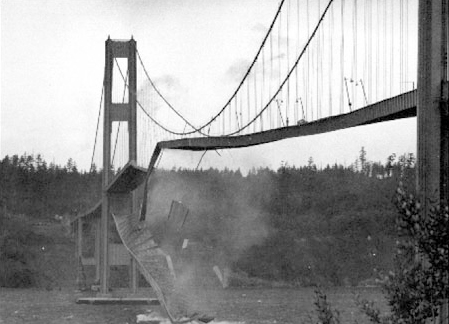

The year was 1940. The place was Tacoma. The event was historic. The disaster was unprecedented. In ordinary winds, a graceful and sleek mile-long bridge, the first to cross the Tacoma Narrows, began undulating with such ferocity that it ripped itself apart as a shocked and mesmerized crowed looked on. Even though no human lives were lost, the unforgettable images of twisting metal and concrete deck sections crashing into Puget Sound immortalized engineering gone wrong. Galloping Gertie, open for only four months at the time of its collapse, became a powerful symbol of the importance of aerodynamics on suspension-bridge stability. That first bridge over the Tacoma Narrows was both a spectacular achievement and a spectacular failure, and its short life forever changed how engineers design bridges.
Next month the American Society of Civil Engineers (ASCE) will remember that fateful day and formally recognize the significant effect the failure of the 1940 Tacoma Narrows Bridge had on advancing the science of suspension-bridge design. A ceremony commemorating the bridge as a civic engineering landmark will be held on Sat., Aug. 11 at 1:30 p.m. at an overlook inside the Living War Memorial Park, located at 7201 6th Avenue, which is the site of a future memorial to be built by ASCE commemorating the landmark designation for the 1940 and 1950 Tacoma Narrows Bridges. Guest speakers will include Tacoma Mayor Marilyn Strickland and Pierce County Executive Pat McCarthy.
ASCE’s Historic Civil Engineering Landmark Program recognizes historically significant local, national and international civil engineering projects, structures and sites. The program identifies and designates national historic civil engineering works that have made a significant contribution to the development of the civil engineering profession. Other western Washington structures receiving the recognition include the I-90 Lacey V. Murrow Bridge in Seattle, the Snoqualmie Falls Underground Generating Station and the Cedar River Hydroelectric Project. Founded in 1852, the ASCE represents more than 144,000 civil engineers worldwide and is America’s oldest national engineering society.





